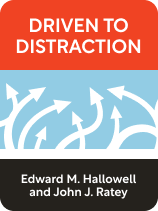

This article is an excerpt from the Shortform book guide to "Driven to Distraction" by Edward M. Hallowell and John J. Ratey. Shortform has the world's best summaries and analyses of books you should be reading.
Like this article? Sign up for a free trial here.
What is the book Driven to Distraction about? What are the main takeaways?
In Driven to Distraction, Edward M. Hallowell and John J. Ratey explore what we know about ADHD through the lens of real people who have it. Hallowell, a psychiatrist, and Ratey, a professor of psychology, both specialize in and have ADHD.
Read below for a brief overview of their book Driven to Distraction.
Driven to Distraction by Edward M. Hallowell and John J. Ratey
In the book Driven to Distraction, Edward M. Hallowell and John J. Ratey argue that while ADHD, or attention deficit hyperactivity disorder, can be a debilitating condition, it can be managed. Proper treatment allows a person to minimize or eliminate the negative symptoms affecting their attention and focus and utilize their strengths.
Edward Hallowell is a psychiatrist and best-selling author of numerous books on psychology, including The Childhood Roots of Adult Happiness and Dare to Forgive. John Ratey is a professor of psychiatry at Harvard and the best-selling author of other self-help books including Spark and Go Wild. Both authors have ADHD themselves. Driven to Distraction is one of several books in a series co-authored by Hallowell and Ratey, including Delivered From Distraction and Answers to Distraction.
What Is ADHD?
ADHD, or attention deficit hyperactivity disorder, is a condition with a wide range of symptoms, usually characterized by inattentiveness or a tendency to be easily distracted, impulsivity, and hyperactivity. People with ADHD often experience difficulty focusing or getting started on tasks, disorganization, and memory issues, among other symptoms.
(Shortform note: The specific traits of people with ADHD vary widely, making it difficult to give a comprehensive definition or settle on an appropriate name for the condition. Some experts have suggested that, instead of naming the disorder to indicate inattentiveness or hyperactivity, we should refer to it as an issue with executive functioning. Executive functioning is the mental skillset we use to do things consciously (as opposed to things we do unconsciously, like breathing) and includes anything that involves planning, remembering, or making decisions.)
Prior to the late 19th century, experts believed ADHD was a condition exclusive to children, which they outgrew by adulthood. But more recent research has proven that it affects adults, as well. This book’s main focus is on ADHD in adults.
(Shortform note: It’s possible that the reason people assumed ADHD only affected children is that people often become calmer as they grow older, making the symptom of hyperactivity (which is often the most visible symptom and was once considered the main or only symptom) less obvious. However, issues of inattentiveness or distractibility can still continue into adulthood.)
The Treatment Process
Now that we’ve explained what ADHD is, let’s discuss how to begin treatment. ADHD can interfere with your success and quality of life, but finding the right treatment can reduce your symptoms and help you make the best use of your strengths. Indeed, people who have ADHD can flourish when their unique needs are met.
(Shortform note: In addition to finding the right treatment, it can also help to develop a “growth mindset” in order to make the best use of your strengths. Helping children shift their focus from immediate rewards to long-term growth helps them manage their stress over difficult tasks and can even change the physiology of their brains, strengthening connections between neurons to improve learning and performance.)
Treatment involves diagnosing the condition, educating yourself and others about it, implementing structure in your life, participating in therapy, and taking medication as needed.

———End of Preview———
Like what you just read? Read the rest of the world's best book summary and analysis of Edward M. Hallowell and John J. Ratey's "Driven to Distraction" at Shortform.
Here's what you'll find in our full Driven to Distraction summary:
- What ADD is, theories on the possible causes, and potential treatments
- How our knowledge of ADD has changed since the book’s republication in 2011
- Tips for how to minimize your negative symptoms and make the most of your strengths






